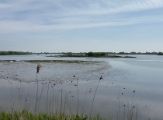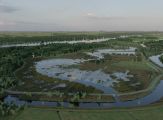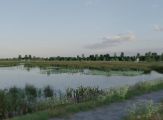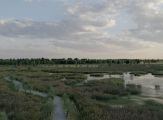Fresh water tidal nature development Sliedrechtse Biesbosch

Fresh water tidal nature development Sliedrechtse Biesbosch
Fresh water tidal nature has become very scarce due to numerous reclamations. This has implications for flora and fauna, which in some cases is specific to these areas. Therefore, Rijkswaterstaat wants to enhance fresh water tidal nature and improve the water quality in places such as the Sliedrecht Biesbosch as part of the Water Framework Directive (WFD). Together with BWZ Ingenieurs, Witteveen+Bos will develop at least 60 hectares of fresh water tidal nature in this area: a unique ecological and landscape task.
The fresh water tidal area of the Sliedrecht Biesbosch is a rare phenomenon found only in delta areas. The area is in open connection with the sea via the Nieuwe Waterweg and Haringvliet rivers. The rising waters at sea constantly push fresh water discharge from the rivers some 50 kilometres further into the river area. When the sea then ebbs again, this pressure drops and the river water flows out. As a result, the area floods at high tide and runs dry at low tide, creating an area of mudflats and marshes. This fluctuation facilitates a biodiverse habitat with vegetation characteristic for fresh water tidal nature and a welcoming ‘home’ for birds and fish.
Comprehensive consideration for area determination
In the first phase of the project, potential sites were identified and considered. The sites were assessed for effectiveness: the contribution to the WFD objectives (areas with high tidal range), and the impact on N2000, Nature Network Netherlands (NNN), protected flora and fauna, safety, spatial quality, land positions, community support, sustainability and costs.
Four sites were selected on which a total of 64 hectares will be developed. We prepared the design for these subareas. This involved an integrated approach: the design was drawn up based on ecology to develop an optimal habitat for flora and fauna. The design was optimised through hydraulic modelling, while the impact on shipping and on tidal flow in the Biesbosch as well as the water quality were assessed. Furthermore, studies were conducted on, among others, recreation, archaeology, flora and fauna, and the design was adjusted accordingly. Engagement and stakeholder management was also carried out.
Rheophilic fish
Flowing side channels suitable as spawning and habitat for rheophilic fish, such as dace and chub, are planned in two subareas. Migratory fish, such as salmon and river lamprey, can also forage here. Furthermore, the area will be landscaped with an intertidal zone, with mudflats, marshes, reeds, rushes and riparian forest. This is an important resting and foraging area for black-tailed godwit, spoonbill, osprey and bald eagle, among others. Islands are designed to provide variation and reduce wave action and erosion. One of the areas will be reconnected to the Merwede by removing polders. A fish passage and nature-friendly verges are planned for the other two subareas.
Project decision
A project decision will be prepared for the design, in accordance with the Environment and Planning Act, which has been in force since 1 January 2024.
More information?




